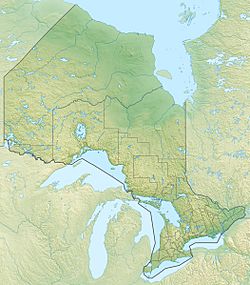Tripoli Lake (Algoma District) facts for kids
Quick facts for kids Tripoli Lake |
|
|---|---|
| Location | Algoma District, Ontario |
| Coordinates | 48°28′33″N 84°47′52″W / 48.47583°N 84.79778°W |
| Primary inflows | Unnamed creek from West Tripoli Lake |
| Primary outflows | Unnamed creek to Tripoli Creek |
| Basin countries | Canada |
| Max. length | 2.1 km (1.3 mi) |
| Max. width | 0.9 km (0.56 mi) |
| Surface elevation | 422 m (1,385 ft) |
Tripoli Lake is a beautiful lake located in the Algoma District of Ontario, Canada. It's part of the huge Lake Superior drainage basin, which means all its water eventually flows into Lake Superior.
This lake is about 2.1 kilometers (1.3 miles) long and 0.9 kilometers (0.6 miles) wide. It sits at an elevation of 422 meters (1,385 feet) above sea level. Imagine being that high up! A major railway line, the Canadian Pacific Railway's main track, even passes right by the southwest side of the lake.
Contents
All About Tripoli Lake
Tripoli Lake is a cool place to learn about how water moves through the land. It's a key part of a larger water system.
Where is Tripoli Lake?
Tripoli Lake is found in the northeastern part of Ontario, Canada. It's in an area called the Algoma District. This region is known for its many lakes and forests.
How Water Flows Through Tripoli Lake
Lakes are often connected by rivers and streams. For Tripoli Lake, water flows in from a stream that comes from West Tripoli Lake. This is called an inflow.
The water then leaves Tripoli Lake through another stream. This is called an outflow. This stream flows into Tripoli Creek. From there, the water travels into the Magpie River. Finally, the Magpie River empties into the mighty Lake Superior. So, water from Tripoli Lake makes a long journey to one of the world's largest freshwater lakes!
Nearby Railway Line
A very important railway line runs close to Tripoli Lake. This is the main line of the Canadian Pacific Railway. It's a transcontinental line, meaning it stretches all the way across Canada. Trains use this line to carry goods and people from one side of the country to the other. It's interesting to think about how nature and human-made structures exist side-by-side.


